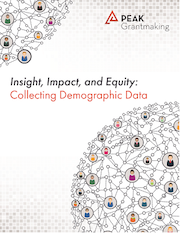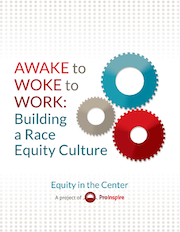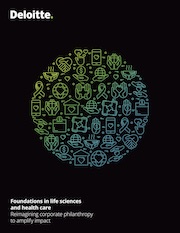Site Search
- resource provided by the Forum Network Knowledgebase.
Search Tip: Search with " " to find exact matches.
The Center for Effective Philanthropy (CEP) collected candid, anonymous feedback over 15 years from more than 100,000 nonprofit leaders to produce this report detailing five things that nonprofits want their donors to know but may not be telling them directly.
Bolder Advocacy works across the country to guide you and your organization through the intricacies of advocacy, to help you understand what’s allowable under the law, to build confidence, and to give you the tools you need to conduct effective advocacy..
Bolder Advocacy is a program of the Alliance for Justice – a national association of 130 organizations that are united by a commitment to a fair, just, and free America where everyone has equal access to justice and can fully participate in our democracy.
Bolder Advocacy gives foundations and their grantees the tools and the confidence to advocate effectively. Foundations and nonprofits turn to us when navigating complex rules governing advocacy, and we work every day to protect and expand the rights of nonprofits and foundations to advocate. Bolder Advocacy can equip your foundation’s staff and trustees with the information and strategies they need to better leverage critical dollars, expertise, and people.

Grantmakers occupy a powerful space of privilege in the social change sector. As such, they have a unique opportunity—and responsibility—to work proactively toward equity and inclusivity. Increasingly, grantmaking institutions are challenging themselves to live their values through their grantmaking practices.
For philanthropy to advance equity in all communities, especially low-income communities and communities of color, it needs to be able to understand the demographics of the organizations being funded (and declined), the people being served, and the communities impacted. That data should be used to assess practices and drive decision making.
PEAK Grantmaking is working to better understand and build the capacity of grantmakers for collecting and utilizing demographic data as part of their grantmaking.
After more than 15 years promoting grantmaker practices that support nonprofit results, GEO is convinced that a strong culture inside foundations is critical for effective philanthropy. It’s virtually impossible to operate as an ally and partner to nonprofits if you are working inside a foundation whose values and culture run counter to that spirit.
GEO defines culture as “the collective behaviors and underlying assumptions of an organization.”
GEO is focusing on culture because of what we hear in our conversations with foundation leaders, staff, board members and nonprofits across the country. People at all levels in their organizations regularly tell us how an unproductive culture can get in the way of what their foundations have the capacity and the potential to achieve. They share that successful grantmaking — grantmaking that supports nonprofits to achieve meaningful results — requires more than a great strategy and execution plan; it also requires an intentional focus on culture.

Achieving race equity — the condition where one’s racial identity has no influence on how one fares in society — is a fundamental element of social change across every issue area in the social sector. Yet the structural racism that endures in U.S. society, deeply rooted in our nation’s history and perpetuated through racist policies, practices, attitudes, and cultural messages, prevents us from attaining it. The impact of structural racism is evident not only in societal outcomes, but in the very institutions that seek to positively impact them
In a sector focused on improving social outcomes across a wide range of issues, we need only look within our own organizations to understand why we have not yet achieved the depth of change we seek. Throughout the social sector, there remains a glaring omission of a fundamental element of social impact: race equity. While issue-specific dynamics play an important role in driving social impact (e.g., public policy around affordable housing or the elimination of food deserts to create access to nutritious foods), the thread of structural racism runs through almost every issue faced by the U.S. social sector. Race equity must be centered as a core goal of social impact across the sector in order to achieve our true potential and fulfill our organizational missions.
Tax Exempt Organization Search helps users find information about a tax-exempt organization’s federal tax status and filings. You can find:
- Organizations eligible to receive tax-deductible charitable contributions (Pub 78 data).
- Automatically revoked organizations
- IRS determination letters dated on or after January 1, 2014
- Form 990-series returns
- Organizations that have filed a Form 990-N (e-Postcard)
Media Impact Funders partnered with Harvard University’s Shorenstein Center on Media, Politics and Public Policy to produce this case study report that surfaces pioneering funding practices in journalism.
As the field of journalism continues to grapple with limited resources and dwindling revenues, it’s clear that financial support is needed now more than ever. Philanthropy, in response to the radically changing landscape, is stepping up to revive quality journalism and reconfigure the news media ecosystem. And, in fact, funding for nonprofit news media has seen a notable uptick in philanthropic support, oftentimes in the form of new types of grants.
Key takeaways from the case studies include:
- The Einhorn Family Charitable Trust, a foundation that doesn’t have a history of journalism funding, made a four-year investment to help launch the Solutions Journalism Network (SJN).
- The LOR Foundation, fearing residents in the Intermountain West did not have access to quality news, decided to partner with SJN on the local level to produce solutions-based news for the region.
- The Ford Foundation supported the hiring of an investigative reporter at the ACLU of Michigan—the first investigative reporter of any ACLU chapter—to dig into the water crisis in Flint, Michigan.
- The California Endowment invested in youth media hubs as a means to promote community health, well-being and empowerment.
- The MacArthur Foundation made a pioneering unrestricted, five-year grant to the Pulitzer Center on Crisis Reporting, which helped the nonprofit newsroom experiment and innovate.
PEAK Grantmaking is working to better understand and build the capacity of grantmakers for collecting and utilizing demographic data as part of their grantmaking. Their work is focused on answering four key questions:
- What demographic data are grantmakers collecting and why?
- How are they collecting these demographic data?
- How is demographic data being used and interpreted?
- How can funders use demographic data to inform their work?
With the help of Kelly Brown, former Executive Director of the D5 Coalition, and an advisory committee of grantmakers, PEAK has completed an expansive survey, interviews with grantmakers, and field research on these four questions.

The role of corporate philanthropy is at a pivotal point as executive, employee, and customer expectations shift and stakeholders increasingly expect businesses to value and invest in societal welfare. In this rapidly evolving environment, there is opportunity for corporate foundations to reevaluate traditional approaches to grant making, social responsibility, and engagement with counterpart organizations.
The life sciences and health care industry provides an exceptionally compelling illustration of macrophilanthropic trends and possibilities. Although all industries can constructively transform existing corporate philanthropy models, the life sciences and health care ecosystem is experiencing dramatic increases in consumer engagement, perceived social responsibility, and global attention that make more thoughtful, strategic philanthropic investment especially urgent. In this paper, they examine the current health ecosystem, evolving stakeholder expectations, the unique position of life sciences and health care foundations to effect critical change,and alternative engagement models with demonstrated track records of success on an international scale.
Rural America is a collection of iconic landscapes, essential industries, and close-knit communities distributed across a land mass so vast it represents 97 percent of the United States. A century ago it was home to half the of all Americans; today, only about 15 percent.
As its population has gotten smaller, rural America has also become challenging to navigate. For millions of people in small towns and remote areas, whether their destination is the grocery store, the beauty parlor, the hospital, or the polls, the question, “How will I get there?” can be complicated.
Mobility—the power to move and travel as we wish—is a huge factor in our health and quality of life, particularly as we get older. Some advocates view it as a basic human right. Almost one quarter of all older Americans (about 10 million), call rural communities home. They share the nearly universal desire to age in place, but their ability to do so hinges on mobility. Without good mobility options, older people face elevated risks of social isolation, depression, gaps in medical care, and malnutrition.
This annual report reveals results of a research study about food insecurity among older adults in the United States. Released by the National Foundation to End Senior Hunger (NFESH) and Feeding America, the study results offer data from the most recent year for which it is available, 2016, and reveals that more older adults faced hunger at this time than before the Great Recession. This latest report also provides information on the characteristics of older adults who struggle to meet their nutritional needs and the rates by state of hunger among this demographic group.
Many foundations are adopting new approaches for supporting social change—approaches that aim to create impact at scale and change systems. As foundations embrace a wider variety of approaches, the roles that foundation staff members play must also change.
Based on in-depth conversations with 114 practitioners representing 50 foundations, Being the Change explores how foundations are rethinking staff size, backgrounds, roles, and culture to better serve their ambitions for social impact.
A CNJG corporate member asked for help with the scenario in which a corporate policy of not supporting religious organizations in their grantmaking, causes problems helping during a disaster in an urban or rural area, when the program that is delivering the disaster relief is based within a church. They want to work with those programs (a church serves as the program’s fiscal sponsor) who support efforts for hunger, homelessness, substance abuse recovery, racial equity, etc. as long as they do not discriminate and do no limit it to their own congregations. The request for policy samples to work around this religious organization hurdle as long as there is no discrimination or funding the actual church’s worship, was compelled by CNJG staff and is listed here.
The focus and scope of this white paper is on the transformation of mobility for older adults in rural areas through technological innovations. The white paper explores the potential for technology research and innovation to transform the rural mobility landscape and, in the process, empower older Americans through meeting their travel needs in an equitable and effective manner.
A CNJG member queried our listserves on what online grants management system members use and would recommend for a small foundation. CNJG compiled these responses, and listed the different systems that members do use.
This report from the TCC Group finds that the flexibility, nimbleness, and willingness to collaborate demonstrated by the philanthropic sector over the past year in response to a rapidly changing policy environment could serve as a model for the sector going forward.
Based on interviews with nearly thirty leaders of philanthropy-serving organizations (PSOs), this report found that in the first year of the Trump administration, PSOs and funder collaboratives were called on to keep funders well informed of policy changes. To that end, PSOs have played a critical role in enabling funder learning, dialogue, and action, and have helped accelerate important funder conversations in the areas of diversity, equity, and inclusion; the need to think beyond issue silos; and the foundational benefits of creating space for dialogue across political and ideological divides through nonpartisan civic engagement.
The report also notes that while some funders have remained cautious, taking a "wait and see" approach to how national political changes might affect their grantmaking priorities, a greater number have been moved by rapidly changing policies to consider aligning their "institutional voice" with other grantmakers to maximize their impact.
Today, the practice of CSR has matured to include strategic philanthropy, employee volunteerism, cause marketing, disaster response, peer-to-peer fundraising, nonprofit board service, and even incorporating social responsibility into core business practices and offerings. Within the pages of this ebook, you’ll hear from leaders who have successfully charted a course for each of these areas to play a role in the new world of CSR.
This article written by Kerry McHugh Vice President and Program Officer at the Helen J. Serini Foundation, an independent foundation located in Maryland, offers ten things to do when meeting with a prospective grantee. She encourage funders to think of these interactions as relationship-building rather than a transaction.
A CNJG member queried the Health & Aging listserves asking for sample letters of inquiry. This document includes a few responses from fellow members. If you would like to add yours to this list, please email us.
Sample job descriptions for President and CEO or Executive Director positions at community foundations.
